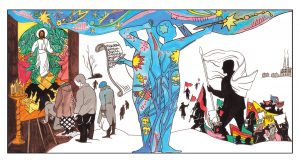Victoria Lomasko, “Atlases,” 2019.
By Emily Erdmann
On Thursday, March 14, students and faculty gathered at King Library’s Special Collections in anticipation of an art reveal. After months of correspondence, coordination, and creation with the Havighurst Center for Russian and Post-Soviet Studies, Russian Artist Victoria Lomasko and Miami staff stood before the newly-minted mural, “Atlases.” The tableau depicts Atlas-inspired figures in the center, holding up the sky with their individual talents of expression, painting, and verse. Everyday life surrounds them from protests on the right to Russian Orthodox believers praying on the left.
Dr. Stephen Norris, Director of the Havighurst Center, first came across Lomasko’s work when her book of graphic journalism, Other Russias, was published two years ago and knew he had to invite her to Miami. At the time, he was unaware of just how much destiny was at play. Walter Havighurst, the center’s benefactor, left a sizeable donation to the Russian center after having been inspired by his nieces’ interaction with Russian culture. They took part in a program that built a bond between two sister cities: Richmond, Indiana, where they lived and where Havighurst retired, and Serpukhov, Russia. Victoria Lomasko’s hometown is this very Russian town.
Today, Lomasko operates from Moscow and visits universities all across the U.S. and abroad. Her graphic work, collected in her recent publication Other Russias, has been published in German, French, English and more. In her work, including her murals, Lomasko tells the story of post-Soviet Russia. From her perspective, there are two sides to this reality: that of the angry and that of the invisible. While the former consists of the outspoken individuals visibly protesting and debating, the latter comprises the artist’s preferred subjects. For her, the invisible are the everyday people who defend the rights of the Russian people—each in their own particular fashion—in much the same way that the Atlas figures in Lomasko’s mural resist the weight of the world with their individual strengths. Drawing the humanity of these everyday heroes diminishes the gap between the concept of “hero” and the viewer. As the latter begins to see themself in the former, Lomasko claims the reader and the hero begin to act as one in the same.
Lomasko maintains that graphic journalism, as opposed to photographic journalism, is the best approach for inciting this transformation because drawings can depict an extra dimension of personality that photography cannot. Refusing to draw from others’ photographs, Lomasko has taken part in every demonstration she possibly could, drawing not just the events but the emotions she witnessed therein. She describes her artwork as her own subjective perspective on post-Soviet Russia, and for this reason, it contains a great number of self-portraits. In one of her works, “The Daughter of an Artist Decorator,” Lomasko depicts herself as a little girl at a protest with a red balloon. Although the nature of the mural is subjective, she puts herself in them conceding that, “obviously a lot of people also saw themselves as the girl with the red balloon.”
Halfway across the world, we cannot all claim to see ourselves in this little girl, but Lomasko’s depictions offer a glimpse into not only the factual existence of everyday happenings in Russia, but the emotions that run through them, and the very people that are affected.
A legacy honored, a mural displayed, and many lives touched—Lomasko’s stay was brief but fruitful.
The mural remains on display on the third floor of King Library, available for all to view. If you’re interested in learning more about Havighurst Center events, specifically those contributing to the Truth and Power series, visit their website: https://miamioh.edu/cas/academics/centers/havighurst/news-events/events/index.html.
Emily Erdmann is a senior majoring in Russian, East European, and Eurasian Studies. She is a Havighurst Dawisha Fellow.

